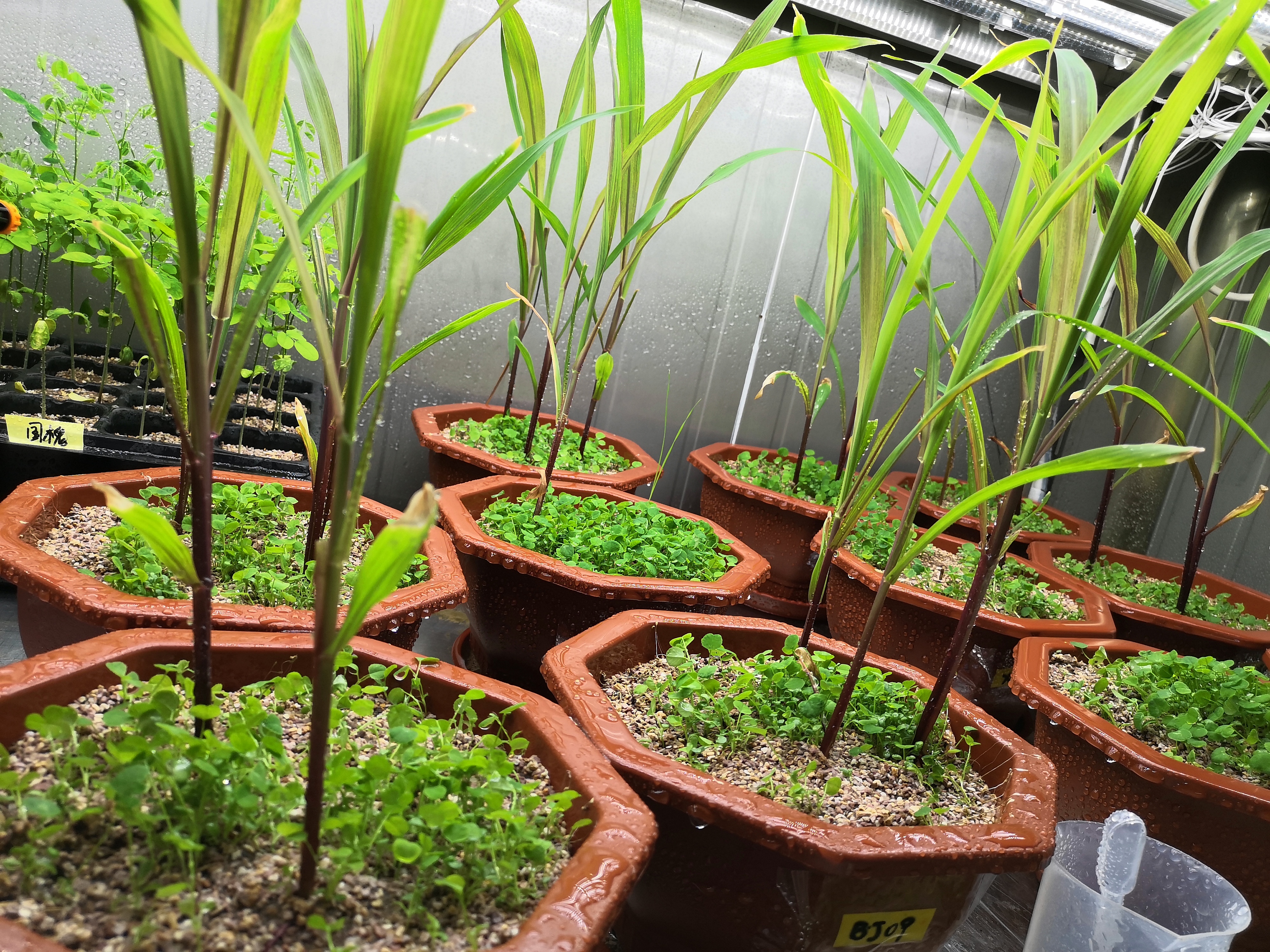 PDF(2541 KB)
PDF(2541 KB)


 PDF(2541 KB)
PDF(2541 KB)
 PDF(2541 KB)
PDF(2541 KB)
接种AMF及施氮对滨海盐土氮矿化的影响
Effects of AMF inoculation and nitrogen application on nitrogen mineralization of coastal saline soil
【目的】研究接种丛枝菌根真菌(arbuscular mycorrhizal fungi,AMF)以及施氮对滨海盐土氮素转化的影响,探究提高滨海盐土氮素供应能力的有效途径。【方法】以江苏北部滨海盐土为研究对象,采用室内培养试验方法,研究接种AMF以及不同施氮水平处理对土壤氮素矿化和氮素供给的影响。【结果】施氮对菌根侵染率具有显著促进作用(P<0.05),低氮处理(N1,施氮量为92 mg/kg)菌根侵染率达45.22%,显著高于高氮处理(N2,施氮量为184 mg/kg)的32.44%,而不施氮处理(N0)菌根侵染率仅有16.00%。在接种AMF 1 d时,低氮处理的滨海盐土铵态氮含量显著低于高氮和不施氮处理的滨海盐土(P<0.05),说明较高的菌根侵染率更有利于植物对铵态氮的吸收与同化,施氮及接种处理显著影响了滨海盐土的氨化过程(P<0.05),但并未对其产生交互作用。硝态氮含量随施氮量的增加而升高,除培养5和10 d外,其余时间点高氮处理滨海盐土的硝态氮含量显著高于低氮以及不施氮处理(P<0.05)的滨海盐土,硝化作用受施氮和接种AMF的交互作用影响。滨海盐土净氮矿化量以及净氮矿化速率在施氮处理和接种处理下差异均不显著(P>0.05),但交互作用对其产生了极显著促进作用(P<0.001)。【结论】对于滨海盐土,添加过多的氮反而抑制丛枝菌根真菌与耐盐植物共生关系的建立;施氮有利于提高滨海盐土的氮矿化作用,施氮量过高并不能对其供氮能力产生促进作用;丛枝菌根真菌与植物共生关系的建立能有效提高氮肥利用效率。施氮和接种AMF通过一定的交互作用对滨海盐土氮矿化过程产生影响。
【Objective】This research aimed to to study the effects of arbuscular mycorrhizal fungi (AMF) inoculation and nitrogen application on the nitrogen mineralization and explore a mechanism to improve the nitrogen supply capacity of coastal saline soils. 【Method】AMF and different nitrogen concentrations were applied to Jiangsu coastal saline soils to evaluate nitrogen mineralization by using laboratory incubation methods. 【Result】Nitrogen had a significant effect on the mycorrhizal infection rate (P <0.05). The mycorrhizal of the low nitrogen treatment (N1, 92 mg/kg) reached a 45.22% infection rate, which was significantly higher than that of the high nitrogen (N2, 184 mg/kg) and control treatments, with 32.44% and 16.00%, respectively. Under the AMF treatment, the content of ammonium nitrogen in the low nitrogen treatment was significantly lower than that in the high nitrogen and control treatments (P <0.05). The higher mycorrhizal infection rate was more conducive to plant absorption and assimilation of ammonium nitrogen. Nitrogen application and inoculation treatment significantly affected the ammoniation process of coastal saline soils (P < 0.05) but did not interact with it. The content of nitrate nitrogen increased with an increase in the nitrogen application. The nitrate nitrogen content in the high nitrogen treatment was significantly higher than that of the low nitrogen and control treatments (P < 0.05). The amount of mineralized nitrogen and the net mineralization rate were not significantly different after the nitrogen application and AMF inoculation (P > 0.05); however, the combined treatment had an interaction effect, which significantly promoted mineralization (P < 0.001). 【Conclusion】For coastal saline soils, excessive nitrogen addition inhibits the establishment of a symbiotic relationship between AMF and salt-tolerant plants; nitrogen application was beneficial to nitrogen mineralization; however, excessive nitrogen did not improve nitrogen supply capacity; the establishment of a symbiotic relationship between AMF and plants could effectively improve the efficiency of nitrogen fertilizer utilization. Nitrogen application and AMF inoculation had a certain interaction effect on the process of nitrogen mineralization in coastal saline soil.

氮矿化 / 施氮 / 丛枝菌根真菌 / 滨海盐土 / 硝态氮 / 铵态氮 / 土壤改良
nitrogen mineralization / nitrogen application / arbuscular mycorrhizal fungi (AMF) / coastal saline soil / $\text{NO}_{3}^{-}-\text{N}$ / $\text{NH}_{4}^{+}-\text{N}$ / soil improvement
| [1] |
王遵亲. 中国盐渍土[M]. 北京: 科学出版社, 1993.
|
| [2] |
全国土壤普查办公室. 中国土壤[M]. 北京: 中国农业出版社, 1998.
National Soil Census Office. Chinese soils [M]. Beijing: China Agricultural Press, 1998.
|
| [3] |
赵宝华, 张金池. 丰县黄泛区盐碱土的形成过程与改良措施[J]. 南京林业大学学报(自然科学版), 2003,27(2):69-72.
|
| [4] |
张文渊. 滨海地区盐碱土类型与形成条件分析[J]. 水土保持通报, 1999(1):22-26.
|
| [5] |
王彤, 封超年, 靳瑞萍, 等. 苏北滨海盐碱土壤盐碱化特征[J]. 江苏农业科学, 2018,46(19):339-343.
|
| [6] |
曾凯, 刘琳, 蔡义民, 等. 地下生态系统中氮素的循环及影响因素[J]. 草业科学, 2017,34(3):502-514.
|
| [7] |
|
| [8] |
刘聪, 李守中, 王从容, 等. 凋落物添加对亚热带水土流失区人工林土壤氮矿化的影响[J]. 福建师范大学学报(自然科学版), 2018,34(4):103-110.
|
| [9] |
王良桂, 张焕朝, 朱强根, 等. 苏北杨树人工林连栽林地土壤氮素矿质化原位研究[J]. 南京林业大学学报(自然科学版), 2009,33(6):69-73.
|
| [10] |
冯烨, 张焕朝, 杨瑞珍, 等. 杨-桤混交林及其凋落物对土壤氮矿化的影响[J]. 南京林业大学学报(自然科学版), 2020,44(2):191-196.
|
| [11] |
|
| [12] |
张先富. 苏打盐碱土对氮转化影响实验研究[D]. 长春:吉林大学, 2011.
|
| [13] |
秦显艳. 尿素施用对盐碱土入渗过程影响的试验研究[D]. 石河子:石河子大学, 2019.
|
| [14] |
|
| [15] |
|
| [16] |
|
| [17] |
|
| [18] |
|
| [19] |
|
| [20] |
|
| [21] |
唐明, 黄艳辉, 盛敏, 等. 内蒙古盐碱土中AM真菌的多样性与分布[J]. 土壤学报, 2007,44(6):1104-1110.
|
| [22] |
马洁怡, 王金平, 张金池, 等. 沿海造林树种根际丛枝菌根真菌与土壤因子的通径分析[J]. 南京林业大学学报(自然科学版), 2019,43(4):139-147.
|
| [23] |
|
| [24] |
鲍士旦. 土壤农化分析[M]. 3版. 北京: 中国农业出版社, 2008.
|
| [25] |
王幼珊, 张淑彬, 张美庆. 中国丛枝菌根真菌资源与种质资源[M]. 北京: 中国农业出版社, 2012.
|
| [26] |
甄莉娜, 王润梅, 杨俊霞, 等. 丛枝菌根真菌与氮肥对羊草生长的影响[J]. 中国草地学报, 2018,40(3):49-54.
|
| [27] |
王健. 不同土壤氮肥力下AM真菌对植物生长及其群落结构的影响研究[D]. 兰州:兰州大学, 2018.
|
| [28] |
|
| [29] |
牟静, 宾振钧, 李秋霞, 等. 氮硅添加对青藏高原高寒草甸土壤氮矿化的影响[J]. 植物生态学报, 2019,43(1):77-84.
|
| [30] |
李大荣, 杨文港, 向嘉. 丛枝菌根对植物营养元素吸收及生长影响的研究进展[J]. 南方农业, 2018,12(27):143-145.
|
| [31] |
罗亲普, 龚吉蕊, 徐沙, 等. 氮磷添加对内蒙古温带典型草原净氮矿化的影响[J]. 植物生态学报, 2016,40(5):480-492.
|
| [32] |
|
| [33] |
张璐, 黄建辉, 白永飞, 等. 氮素添加对内蒙古羊草草原净氮矿化的影响[J]. 植物生态学报, 2009,33(3):563-569.
|
| [34] |
|
/
| 〈 |
|
〉 |